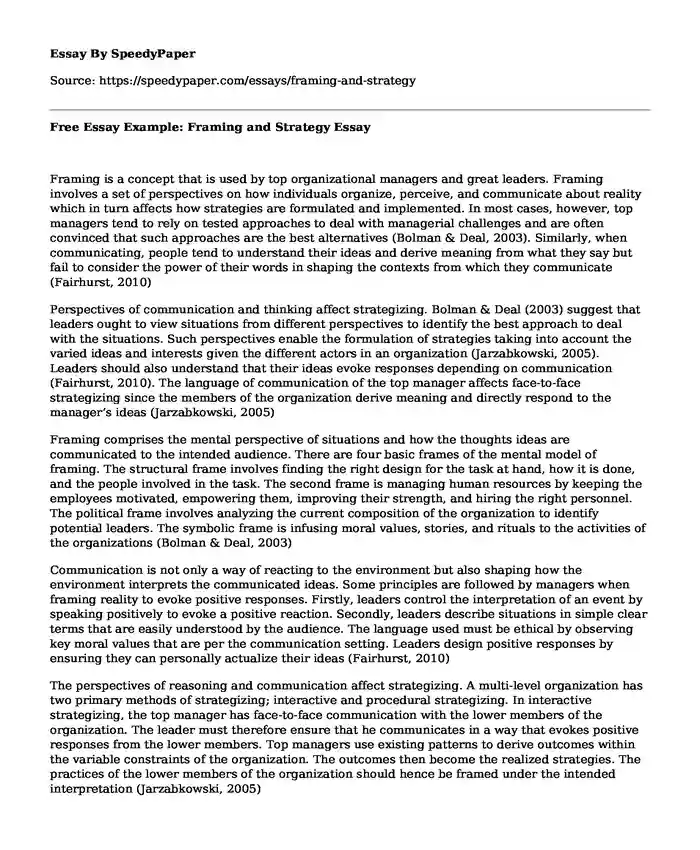
| Type of paper: | Essay |
| Categories: | Strategic management Organizational culture Interpersonal communication Leadership management Essays by wordcount |
| Pages: | 3 |
| Wordcount: | 720 words |
Framing is a concept that is used by top organizational managers and great leaders. Framing involves a set of perspectives on how individuals organize, perceive, and communicate about reality which in turn affects how strategies are formulated and implemented. In most cases, however, top managers tend to rely on tested approaches to deal with managerial challenges and are often convinced that such approaches are the best alternatives (Bolman & Deal, 2003). Similarly, when communicating, people tend to understand their ideas and derive meaning from what they say but fail to consider the power of their words in shaping the contexts from which they communicate (Fairhurst, 2010)
Perspectives of communication and thinking affect strategizing. Bolman & Deal (2003) suggest that leaders ought to view situations from different perspectives to identify the best approach to deal with the situations. Such perspectives enable the formulation of strategies taking into account the varied ideas and interests given the different actors in an organization (Jarzabkowski, 2005). Leaders should also understand that their ideas evoke responses depending on communication (Fairhurst, 2010). The language of communication of the top manager affects face-to-face strategizing since the members of the organization derive meaning and directly respond to the manager’s ideas (Jarzabkowski, 2005)
Framing comprises the mental perspective of situations and how the thoughts ideas are communicated to the intended audience. There are four basic frames of the mental model of framing. The structural frame involves finding the right design for the task at hand, how it is done, and the people involved in the task. The second frame is managing human resources by keeping the employees motivated, empowering them, improving their strength, and hiring the right personnel. The political frame involves analyzing the current composition of the organization to identify potential leaders. The symbolic frame is infusing moral values, stories, and rituals to the activities of the organizations (Bolman & Deal, 2003)
Communication is not only a way of reacting to the environment but also shaping how the environment interprets the communicated ideas. Some principles are followed by managers when framing reality to evoke positive responses. Firstly, leaders control the interpretation of an event by speaking positively to evoke a positive reaction. Secondly, leaders describe situations in simple clear terms that are easily understood by the audience. The language used must be ethical by observing key moral values that are per the communication setting. Leaders design positive responses by ensuring they can personally actualize their ideas (Fairhurst, 2010)
The perspectives of reasoning and communication affect strategizing. A multi-level organization has two primary methods of strategizing; interactive and procedural strategizing. In interactive strategizing, the top manager has face-to-face communication with the lower members of the organization. The leader must therefore ensure that he communicates in a way that evokes positive responses from the lower members. Top managers use existing patterns to derive outcomes within the variable constraints of the organization. The outcomes then become the realized strategies. The practices of the lower members of the organization should hence be framed under the intended interpretation (Jarzabkowski, 2005)
In procedural strategizing, the lower members of the organizations follow strategies that are already mapped out by the top managers and hence are communicated formally. The strategizing procedure does not require managerial attention. However, the implementation of the strategy solely relies on the perspective of the current top management (Jarzabkowski, 2005). Generally, successful strategizing in any organization results from having positive, varied, and reasonable frames of thoughts and communication of the thought ideas.
References
Bolman, L. G., & Deal, T. E. (2017). Reframing organizations: Artistry, choice, and leadership. John Wiley & Sons. https://books.google.co.ke/books?id=1PLCDwAAQBAJ&lpg=PR9&ots=paGPhHdrOV&dq=bolman%20and%20deal%20reframing%20organizations&lr&pg=PR9#v=onepage&q=bolman%20and%20deal%20reframing%20organizations&f=false
Fairhurst, G. T. (2010). The power of framing: Creating the language of leadership (Vol. 290). John Wiley & Sons. https://books.google.co.ke/books?id=tPR4sSnciHwC&lpg=PR13&ots=8TJfmy7C-h&dq=fairhurst%202010&lr&pg=PR13#v=onepage&q=fairhurst%202010&f=false
Jarzabkowski, P. (2005). Strategy as practice: An activity-based approach. Sage. https://books.google.co.ke/books?id=SR5kGCz1DGQC&lpg=PP11&ots=yEqkUTJa1b&dq=%20jarzabkowski%202005&lr&pg=PP11#v=onepage&q=jarzabkowski%202005&f=false
Cite this page
Free Essay Example: Framing and Strategy. (2023, Nov 24). Retrieved from https://speedypaper.net/essays/framing-and-strategy
Request Removal
If you are the original author of this essay and no longer wish to have it published on the SpeedyPaper website, please click below to request its removal:
- Free Essay Sample on Propositional Debate
- Student Athletes and Non-Student Athletes Essay Sample
- HRM Essay Sample: Enhancing Creativity in the Research and Development Department
- Mentorship in a Mental Health Facility, Essay Example
- Understanding Gifted Kids From the Inside Out. Paper Example
- Essay Sample on Hazard Prevention and Control Program
- Free Essay: Obesity in African American Culture
Popular categories




